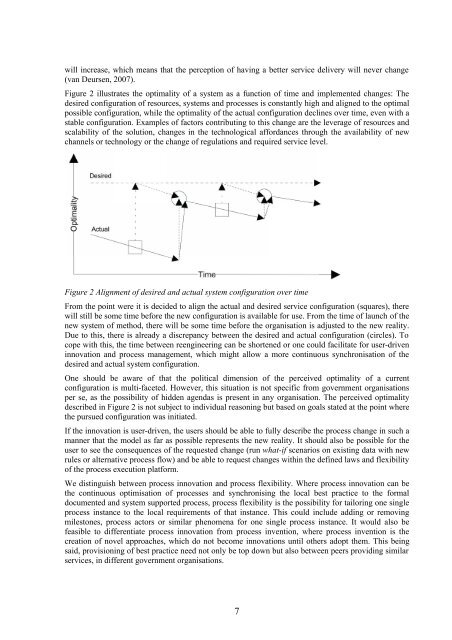Multi-channel provisioning of public services - Department of ...
Multi-channel provisioning of public services - Department of ...
Multi-channel provisioning of public services - Department of ...
Create successful ePaper yourself
Turn your PDF publications into a flip-book with our unique Google optimized e-Paper software.
will increase, which means that the perception <strong>of</strong> having a better service delivery will never change<br />
(van Deursen, 2007).<br />
Figure 2 illustrates the optimality <strong>of</strong> a system as a function <strong>of</strong> time and implemented changes: The<br />
desired configuration <strong>of</strong> resources, systems and processes is constantly high and aligned to the optimal<br />
possible configuration, while the optimality <strong>of</strong> the actual configuration declines over time, even with a<br />
stable configuration. Examples <strong>of</strong> factors contributing to this change are the leverage <strong>of</strong> resources and<br />
scalability <strong>of</strong> the solution, changes in the technological affordances through the availability <strong>of</strong> new<br />
<strong>channel</strong>s or technology or the change <strong>of</strong> regulations and required service level.<br />
Figure 2 Alignment <strong>of</strong> desired and actual system configuration over time<br />
From the point were it is decided to align the actual and desired service configuration (squares), there<br />
will still be some time before the new configuration is available for use. From the time <strong>of</strong> launch <strong>of</strong> the<br />
new system <strong>of</strong> method, there will be some time before the organisation is adjusted to the new reality.<br />
Due to this, there is already a discrepancy between the desired and actual configuration (circles). To<br />
cope with this, the time between reengineering can be shortened or one could facilitate for user-driven<br />
innovation and process management, which might allow a more continuous synchronisation <strong>of</strong> the<br />
desired and actual system configuration.<br />
One should be aware <strong>of</strong> that the political dimension <strong>of</strong> the perceived optimality <strong>of</strong> a current<br />
configuration is multi-faceted. However, this situation is not specific from government organisations<br />
per se, as the possibility <strong>of</strong> hidden agendas is present in any organisation. The perceived optimality<br />
described in Figure 2 is not subject to individual reasoning but based on goals stated at the point where<br />
the pursued configuration was initiated.<br />
If the innovation is user-driven, the users should be able to fully describe the process change in such a<br />
manner that the model as far as possible represents the new reality. It should also be possible for the<br />
user to see the consequences <strong>of</strong> the requested change (run what-if scenarios on existing data with new<br />
rules or alternative process flow) and be able to request changes within the defined laws and flexibility<br />
<strong>of</strong> the process execution platform.<br />
We distinguish between process innovation and process flexibility. Where process innovation can be<br />
the continuous optimisation <strong>of</strong> processes and synchronising the local best practice to the formal<br />
documented and system supported process, process flexibility is the possibility for tailoring one single<br />
process instance to the local requirements <strong>of</strong> that instance. This could include adding or removing<br />
milestones, process actors or similar phenomena for one single process instance. It would also be<br />
feasible to differentiate process innovation from process invention, where process invention is the<br />
creation <strong>of</strong> novel approaches, which do not become innovations until others adopt them. This being<br />
said, <strong>provisioning</strong> <strong>of</strong> best practice need not only be top down but also between peers providing similar<br />
<strong>services</strong>, in different government organisations.<br />
7
















